View Barbara’s Photo Album of this area on Picasa.com
Hi, Everyone,
I never would have thought we would still be stuck here in Aden, Yemen. We arrived on March 24 and now it is April 13, the day after Easter. We had planned a quick stop for only two or three days to buy food and fuel. But we are still here, having fixed the water pump and now waiting for our new starter motor. The mechanic said it cleared customs in Sana’a (the capital) yesterday morning and was trucked down to Aden (a six hour drive) yesterday afternoon and evening, and he will install it this morning, “God willing.” Once the engine is running, we will motor over to the fuel dock, then we are outta here, headed up the Red Sea.
More Pirate News. I’m sure you all are following the big news story about the pirated Maersk Alabama and the brave captain who gave himself up to the pirates as a hostage to save his crew and ship. He and the pirates are still drifting around in the lifeboat, out of fuel, while the USS Bainbridge circles around them. The pirates are demanding a $2 million ransom while the FBI negotiates his release. We all hope for a quick, peaceful and safe (at least for the US captain and FBI/military) resolution to the ordeal. What you may not have heard is that the number of pirate attacks is at an all time high, averaging a little over one a day now, and extending from Kenya out to the Seychelles, the east coast of Somalia out hundreds of miles, the Gulf of Aden between Somalia and Yemen, and also well up into the southern half of the Red Sea. We are very much relieved to have made it through the Gulf of Aden without incident, but we are not out of harms way yet. Plus we read reports of pirate attacks in the Med, the Caribbean, and both the Pacific and Atlantic coasts of Central America. Piracy is truly a world wide problem. Yesterday, I saw in Google News that those Newport Beach pirates, who posed at a yacht buyer and dumped the owners’ bodies overboard tied to an anchor, were just convicted and sentenced to death. At times, it is even in our own back yard.
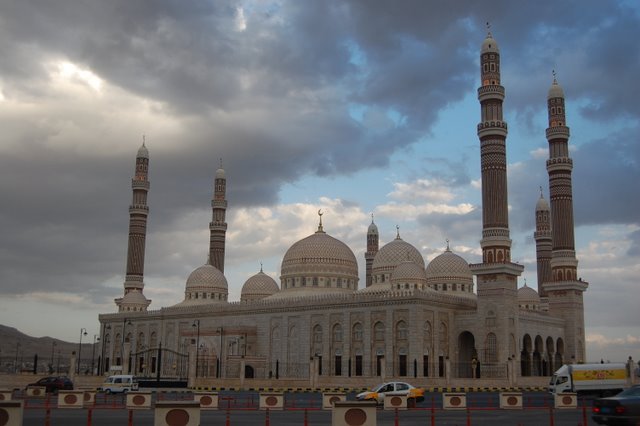
The Side Trip to Sana’a. Since we had several days to kill waiting for the starter motor to arrive from Japan, we decided to fly (45 minutes, $110 round trip) to the ancient capital of Yemen to do some site seeing and visit the US Embassy. We stayed in Old Sana’a (Google it for photos) for two nights in a castle-like 15 room hotel that was hundreds of years old. It was a six story walk-up with steep stone steps (no elevators, and our room was on the fourth floor). We arrived at 10 pm during a power outage (nearly a daily occurrence) so there were candles lighting the stairway as we climbed up to our room. The doors were ancient, with a huge skeleton key that turned an old lock to open our room. The thick, wooden doors are all very old and very short, only about 50 to 55 inches high. Most of the buildings in Old Sana’a, which is a World Heritage Site, are 1200 to 1400 years old, and most of them are out of stone and bricks made with mud and straw. The streets are very narrow and winding, making it very easy to get lost. The windows in all the buildings are arched with colored glass, and at night their beauty is astounding.
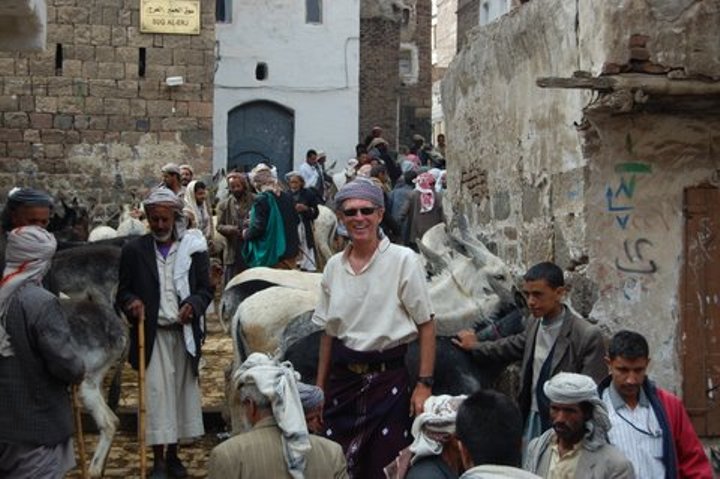
The Donkey Auction. In our first morning, spent walking around and exploring, we came across a crowded marketplace with a donkey auction going on. There were dozens of donkeys, men in their traditional dress, the bidding was lively and the scene was a colorful spectacle. Women walked by on their way to market, all dressed in black burkas. Nearly all the men are dressed with a large dagger they wear prominently tucked inside the front, held by a huge belt. The dagger is a symbol of their honor and virility (sp) and the larger the dagger. . . bb here, once Michael found that out, he had to trade his small dagger in for a larger one!! (-:
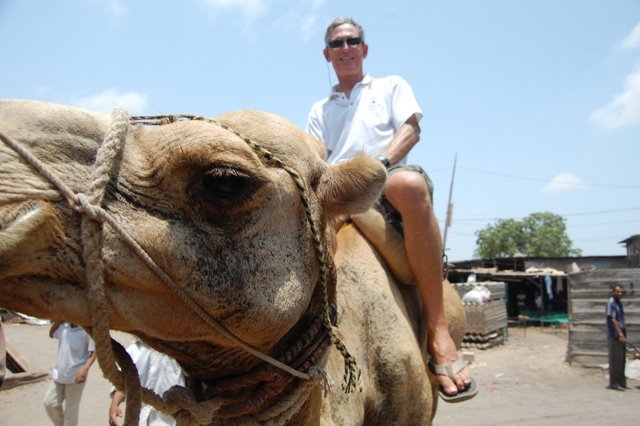
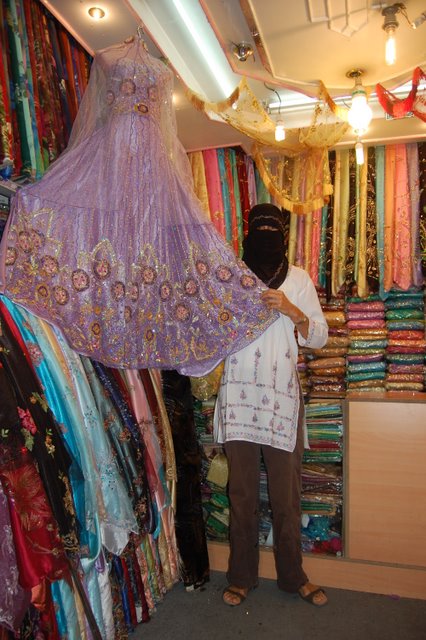 Â
 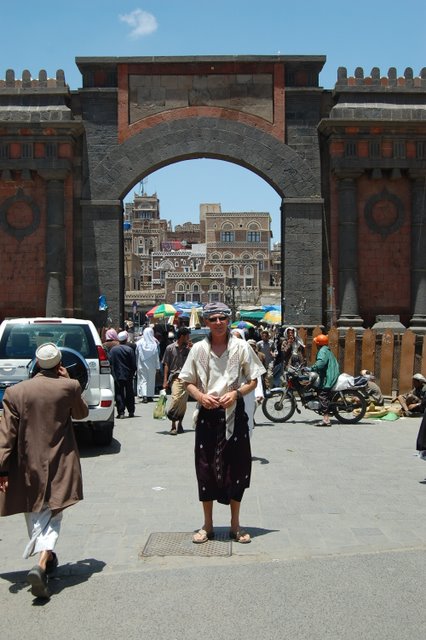
Barbara’s Princess Jasmine Dress. Later in our walkabout in the old marketplace, we came upon a dress shop, and I spotted a full length lavender beaded dress that looked like a cross between an Opera Ball gown and a costume from a Disney production of Aladdin, in three pieces: a long skirt, the top and a veil. None of the shop keepers spoke English, but another lady shopping with her husband (she was in a black burka and you could only see her eyes) volunteered to help. Her English was very good and she used to work for Yemenia Airlines, but her husband spoke only Arabic. We exchanged cell phone numbers with the couple who helped us at the dress shop and promised to call to get together the next day. The dress was actually just fabric and had to be sewn into a dress at another shop, which we managed to get done in less than 24 hours. The tailor’s shop was tiny, with no dressing room, but Barbara needed to try it on to make sure it fit well, so the three tailors had to leave their shop and I helped Barbara zip up the dress. It needed a few more minor stitches here and there, which they did quickly while we waited, with a growing crowd of villagers watching every move and trying to get our attention to practice their English: “Good morning” (even though it was well into the afternoon), “Where are you from?” “Oh, America. Obama good. Welcome to Yemen!”
Everywhere we go, the local Yemenis are very warm and friendly toward us. They seem surprised when we tell them we are from America–there are so few tourists from any country here and American tourists are extremely rare. With many people we meet or say hi to on the street, we get the feeling that we may be the first Americans they have seen. The children are especially amazed to see a woman unveiled with not even her head covered!
The US Embassy. We needed to get extra pages added to our passports because they are full with stamps, and for traveling Americans that must be done at a US Embassy. Because the Embassy in Sana’a was bombed a few months ago, with a few killed (Yemeni people, not Americans) and many injured, security was incredibly tight, with vehicle barricades, soldiers with machine guns everywhere, and several checkpoints. I was dressed in a typical Yemeni outfit that I bought as a souvenir, which went over well. The Embassy is huge, with many buildings spread out to the point where a bus is used to get people around. There must have been over 1,000 employees, with about 20% of them in security. Almost without exception, an advanced appointment is required, but we managed to be the exception and, after waiting nearly two hours and filling out forms, including a list of countries visited and that we plan on visiting (it’s over 60 countries), we got 20 pages added to our passports.
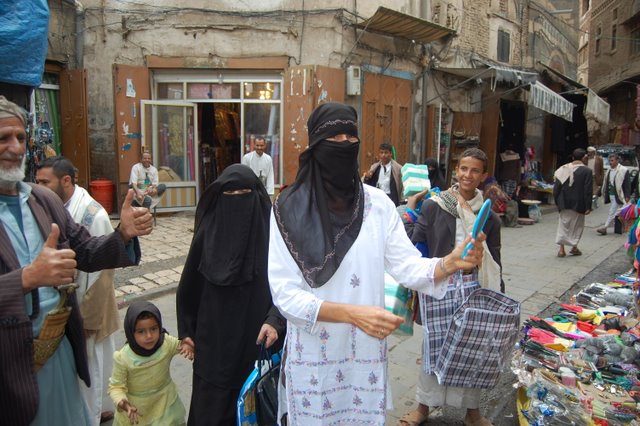
Women in Yemen. Life is tough for the women in this country. Although things are improving, change comes very slowly. Nearly all of the women wear black burkas, and many wear gloves, covering every square inch of their body and leaving only a narrow slit for their eyes. Up until a few years ago, women were not allowed to drive (we still did not see even one women driving), vote, own real property or inherit. At a father’s death, all of his property is passed to his sons only, with nothing inherited by the daughters. An international women’s rights organization recently ranked the 130 countries of the world as to the quality of life and other women’s rights issues, and Yemen came in last place.
 Â
 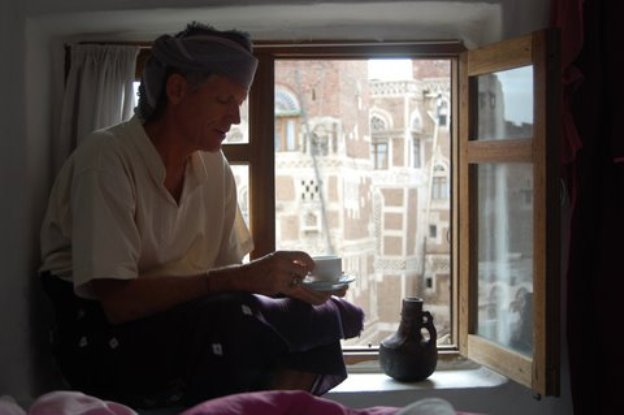
Locusts Swarming. We have not seen any yet, the Yemen Observer newspaper is reporting swarms of locusts over much of the agricultural land in this country, with densities estimated at 100 locusts per square meter.
Land Mines. Good thing we are not shepherds wandering the countryside here. Yemen is loaded with land mines, the local paper reported. Hundreds of thousands of them, scattered along back roads and the outskirts of 592 villages, spread over 923 million square meters, the product of multiple civil wars. In a nationwide effort to clear land mines, in just a few months 165,000 were found and deactivated. Over the past few years, 4,500 victims–many of them shepherds–have died or been severely injured (not counting all the sheep) from land mines here.
Qat. At the US Embassy, in the room where Yemenis wait to get their visas to visit the US, there is a large poster warning that qat is illegal in the US and cannot be imported, even in small quantities. It describes qat as an addictive psycho-tropic drug. Qat is a tobacco-like leafy shrub, and about 80% of the men and 25% of the women chew qat, usually daily. They get a big wad of it going over several hours, growing to the size of a golf ball, and keep it off to the side of their mouth causing their cheek to bulge out. Shop keepers, taxi drivers, even gun-carrying police officers on duty–it seems everyone not only does qat but gets whacked out on it. The Yemeni believe one of its many qualities is it acts as an aphrodisiac. It is sold openly in the marketplaces, right next to the fruits and vegetables. It is the major crop, by far, with nearly 80% of the agricultural land here in Yemen now devoted to cultivating qat. Barbara and I both tried some and got a little buzz going, but we didn’t like it and it just upset our stomachs.
Shisha Pipe. Another Yemeni tradition is to smoke a water pipe called a shisha. That is not too surprising. But what is surprising is what is smoked in the pipe. It’s not hashish, pot or even tobacco. It is fruit, in a rock hard, crystalized form, with the favorites being apple and grapefruit. It is usually smoked after dinner, and a shisha is offered at the finer restaurants. Barbara and I tried some, took a few hits, and liked it, sort of. Maybe we just liked trying something so different in such a different culture.
We spent our last afternoon in Sana’a with that couple (names not included for their privacy, Barbara is insisting . . .) we met in the dress shop the day before. We went to lunch together, which was interesting because, after a privacy screen was placed around our table to keep other guests and even the waiter out, our friend dropped her veil. Obviously she needed to do that in order to eat, but it is a very strange custom, and for the first time we saw the face of the person we have been talking with and trying to get to know for the past few hours. Throughout the Muslim world, and particularly in this country, we were told that it is a huge taboo for a single woman to be with a single man so, when we first met this couple at the dress shop, Barbara introduced me as her husband. After spending a few hours with this couple, first over lunch then touring the town, next chewing qat and finally smoking a shisha together, our female friend asked us to tell her about my marriage proposal to Barbara, as our first date in Hawaii had been so amazing. Barbara came clean and told her that we weren’t really married. I thought they would be insulted that we were not honest with them and offended that we were pretending to be husband and wife. They were not shocked as actually they have a few skeletons in the closet themselves. Barbara just deleted the details as she had promised them nothing private about them would go on the internet since they are a private people/country as a whole.
Got to go. The mechanic should be here any minute. God willing.
Cheers,
Michael and Barbara